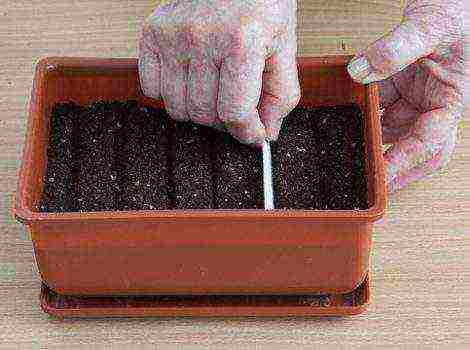Content [show]

How to grow an apricot from a stone, if in Russian conditions even varietal seedlings do not always turn into fruit-bearing apricot trees? Is there enough heat for a small bone to sprout, and how to help a delicate plant adapt to an unusual climate? Following our recommendations, you will see from your own experience that this task is not as difficult as it seems.
Does it make sense to grow an apricot from a stone?
Now you can easily buy quality apricot seedlings on the market or order online. The varieties are offered zoned, adapted to the Russian climate, and the variety of varieties makes it possible to choose apricots with the best characteristics. Why create difficulties for yourself, trying to get a big tree from a small bone?
The reasons may be different: someone is confused by the high cost of seedlings (after all, for effective pollination, it is advisable to plant 2-3 apricot trees), others cannot achieve good fruiting from varietal seedlings, others like to experiment by creating new varieties of apricots.
Video about planting an apricot from a stone
In one opinion, gardeners who practice the cultivation of apricot from stone converge: the trees are more unpretentious, adapted to the local climate and soil characteristics. The main care for apricots is reduced to watering and fertilizing, while pests are practically not necessary to fight. In addition, you can plant as many seeds as you like, subsequently selecting the strongest plants - a great opportunity to create a gorgeous apricot garden!
Parental qualities when planting an apricot kernel are rarely inherited, but unlike those grown from apple seeds, there is much less risk of getting wild. From stone fruits, seedlings are often obtained that surpass their parents in taste and fruit size.
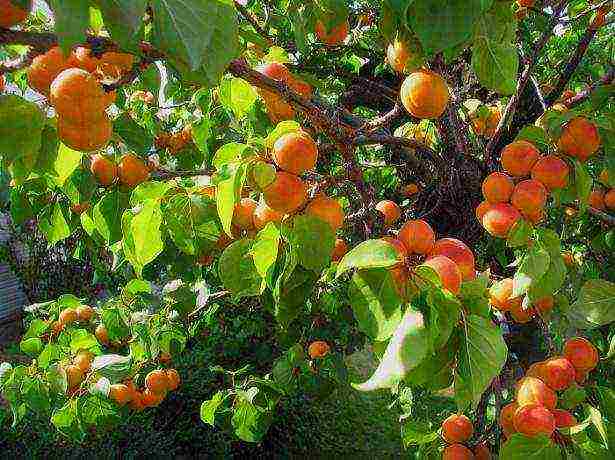
The main care for apricots is reduced to watering and fertilizing
Apricot - from preparing seeds to planting in the ground
For planting, it is best to take seeds from apricots that grow in your area. If you can't get local fruits, you can order planting material from gardeners who live in the Far East or Siberia. Apricots growing in such harsh climatic conditions are highly viable, therefore, their descendants will take root well in any corner of Russia.As a last resort, you can use apricot pits bought on the market. Just do not take large fruits of imported varieties - it will be difficult to grow them.
Use the best apricots for reproduction, slightly overripe, with easily separated flesh. Rinse the resulting bones and dry in the shade.
It is not recommended to plant seeds in pots, because they need natural hardening. A seedling carefully grown at home will simply die at the first frost, it is worth transplanting it to the street. However, do not expect that all crops will sprout on the apricot garden bed: after a harsh winter, only the strongest sprouts will survive. And if you plant the bones in the ground in early autumn, then rodents will immediately take away a good part. Therefore, planting should be done in mid-autumn, before the ground freezes, or in mid-spring.
Before the autumn planting, it is enough to place apricot pits in water for a day in order to immediately reject those that have surfaced. The remaining bones are planted in trenches to a depth of 6 cm, every ten centimeters. For best results, you can make the trenches a little deeper and lay out the bottom with a mixture of grass, sand, earth and humus. It is also advisable to sprinkle it with humus and grass on top of the garden. During the winter, the apricot pits will undergo natural hardening, and in the spring, tender sprouts will appear.
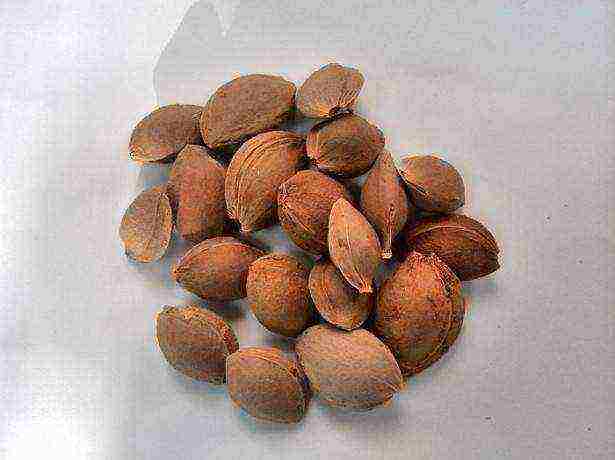
Planting seeds in pots is not recommended, because they need natural hardening
If planting is postponed to spring, the apricot pits will need to be stratified (as when growing pitted cherries). You can put the seeds in a box of sand and put them in the refrigerator for the whole winter, or take dry seeds in mid-March and put them in water for three days, remembering to change it every day. After soaking, the planting material is placed in wet sand and moved to the basement, and in April it is sown in open ground, as soon as the weather permits.
Growing and caring for an apricot in the first year
Green shoots that appear in spring can be killed by crows, magpies, hares and small rodents. For protection, experienced gardeners cover delicate plants with transparent plastic bottles with cut-off bottoms. Such a simple solution does not require financial costs and unnecessary efforts, allowing apricot seedlings to grow and gain strength in peace.
Over the summer, with regular watering and careful loosening of the earth, apricots have time to grow well. Therefore, in September, they can be transplanted to a permanent place - it is better if it is sunny, although in the shade the trees will also bring decent harvests.
Video about growing and caring for apricots
Tips for growing apricots from seeds:
- Pits for transplanting seedlings should be prepared in advance, filling the bottom with a mixture of humus, ash, leaves, tops and grass. On top of organic fertilizers, soil is poured and the roots of the seedlings are spread over it, completely filling the planting hole with earth.
- From the first year in March, pruning of apricot seedlings is carried out, removing weak and frozen branches and shortening too long shoots.
- In summer, the seedlings are watered abundantly once every two weeks, sprinkling sawdust on the near-stem circle to protect it from drying out.
- Since apricot trees grown from stone lack a central trunk, special attention should be paid to the formation of the crown of the seedlings.
- From the fifth year, the trees begin to bear fruit abundantly, at this time it is recommended to put props under the branches so that they do not break under the weight of the fruit.
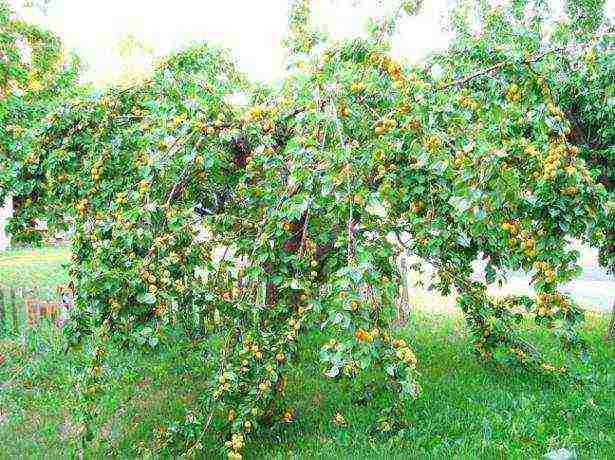
From the fifth year, the trees begin to bear fruit abundantly.
It is actually easier to care for apricot trees that were grown from ordinary seeds, because they are characterized by increased unpretentiousness and can bear fruit remarkably even on infertile land.According to experienced gardeners, such apricot trees delight with annual rich harvests and excellent fruit taste.
Growing an apricot from a stone is an interesting and exciting process. A young tree can be planted in open ground, or you can leave it at home.
Is it possible to grow an apricot from a stone at home
Apricot grown from seed is more adapted to the local climate than seedlings brought from other regions. However, the process of seed germination is long, in order to speed it up, you need to plant it correctly. Usually apricots are planted right in the ground before winter, but if mice live on the site, they can eat all the bones, so it is better to grow seedlings at home.
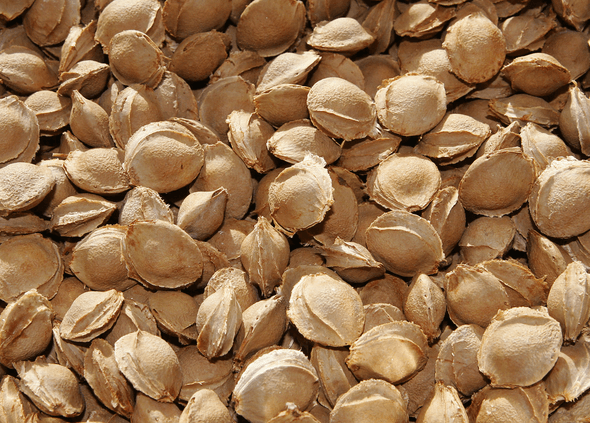
To prevent mice from eating apricot seeds planted in open ground, they can be grown at home.
How to germinate an apricot pit
Inside each fruit is a hard drupe with a nucleus. In order for the seed to germinate, stratification is necessary - prolonged exposure to certain temperatures. Fresh seeds show the best germination. Cooked apricot pits from compote will never sprout.
If the tree in the future is planned to be planted in open ground, then the choice of planting material must be taken responsibly. For planting, choose seeds from sweet apricots, taste not only the pulp, but also the nucleolus.
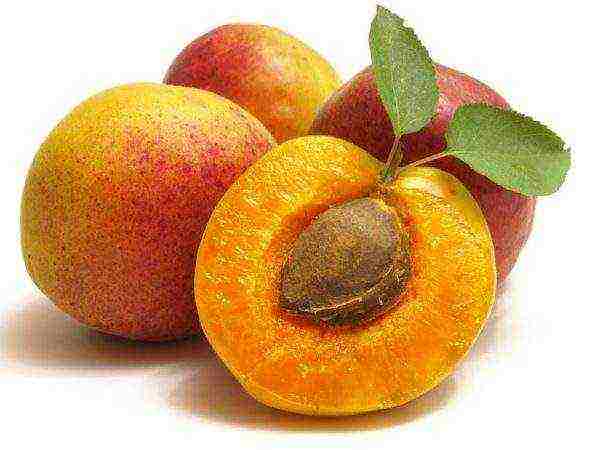
Before planting, taste not only the pulp, but also the apricot kernel, which should not be bitter
Sweet apricots also have a sweet kernel - the fruits of a tree grown from such a seed are likely to be tasty too.
Soak the bones in water and remove the floating ones. Dry bones need to be soaked for about three days, be sure to change the water every day. In this case, it is advisable to use rain, melt or spring water.
Do I need to germinate a seed before planting
To get guaranteed shoots of apricot, it is advisable to germinate the seed before the root appears. To do this, stratification is carried out in a cool place - a refrigerator or cellar:
- The soaked bones are sprinkled with washed river sand, vermiculite or sawdust. Then moisten and place in a container or bag.
- The container is left in a cool place, for example, in a refrigerator, and kept there at a temperature of +2 ° C.
- Usually after 90-100 days roots begin to hatch.
Be sure to check the seeds during the stratification period so that they do not dry out or become moldy due to excess moisture.
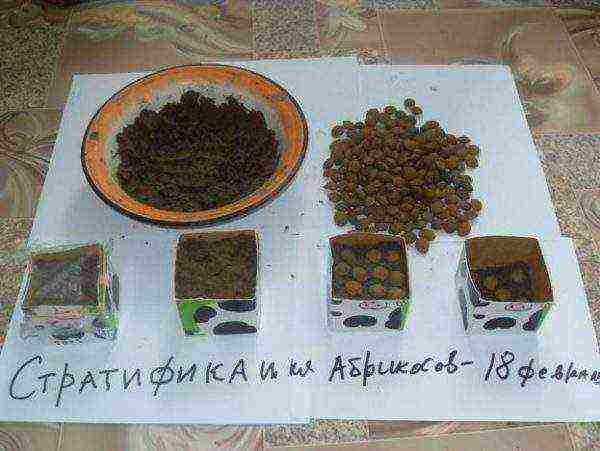
For the best germination of apricot seeds, it is necessary to stratify them before planting.
If it is necessary to speed up stratification, the container is periodically placed in the freezer for several hours, then transferred to a shelf for storing fruits, where the temperature is + 6 ... + 10 ° С. So the bones are kept until planting in the ground or pots.
It is much easier to observe bones placed in damp cloths and a plastic container.
Video: stratification of seeds in tissue and planting them
How to plant a pitted apricot
In the natural environment - in the open ground - apricot pits hatch only with the arrival of spring after the snow has melted. If stratified in the refrigerator, then pecking occurs in about three months.
Choosing a pot for planting
When growing apricot seedlings at home, it is better to take individual containers for each seed. Since the root system of the apricot is pivotal, the pot should be deep: it is better to take a half-liter disposable glass or a cut one and a half liter bottle.
At the bottom of each glass, it is imperative to make holes to drain excess water.

A tall plastic cup is perfect as a container for planting apricots
Soil for apricot
Apricot is not very picky about the acidity of the soil, so the soil can be bought universal or for seedlings, based on peat.However, such soils are often not of good quality, so it is better to prepare the soil mixture yourself.
For 10 liters of garden soil or purchased soil, 1 liter of biohumus is taken and 1 glass of vermiculite is added. These components will give nutrition and looseness to the prepared soil mixture. To retain moisture, it is advisable to add soaked coconut substrate; for this, the briquette is poured with 1-2 liters of water and, after swelling, is mixed with soil.
Photo gallery: components for high-quality soil mixture
Planting process
The growth and development of the seedling will depend on the correct planting of the apricot kernel.
Planting stages:
- At the bottom of the selected pots we pour drainage - small expanded clay.
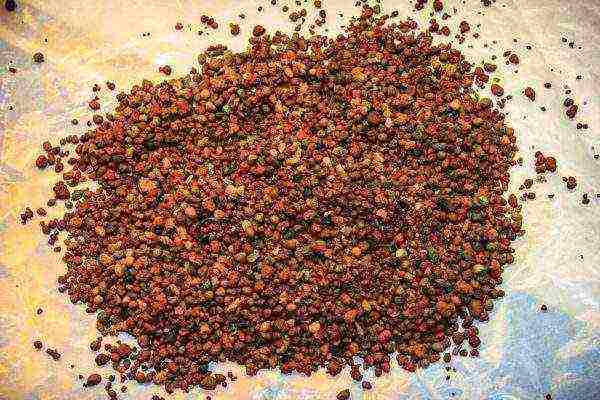
Fine expanded clay must be placed on the bottom of the apricot container
- We put the prepared soil mixture into the pot, without adding 1–2 cm to the edge of the pot, and slightly compact it.
- We lay out the sprouted apricot seeds on the surface of the soil, 1 seed per pot, with the root down. Do not deepen the bone, as this can subsequently lead to decay of the root collar. You can sprinkle earth only on the spine itself.
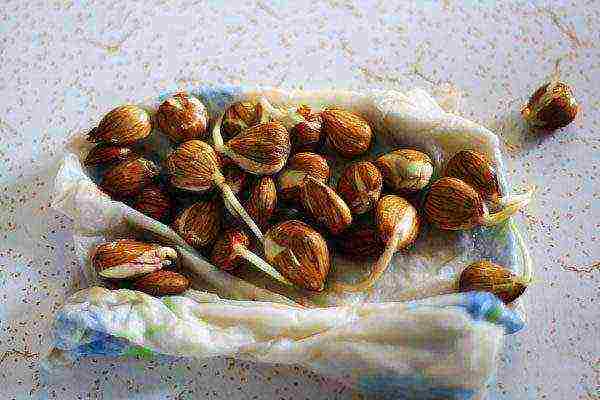
It is better not to burrow sprouted apricot seeds into the ground, so as not to provoke further decay of the root collar
- Lightly water the bone and cover with a film so that the moisture does not erode, and we place the pot itself in a warm place.
- We periodically inspect the plantings: ventilate and remove condensate from the film.
- As soon as sprouts appear, we rearrange the pots on a light warm windowsill, you can also put them under phytolamps if there is no sunny window.
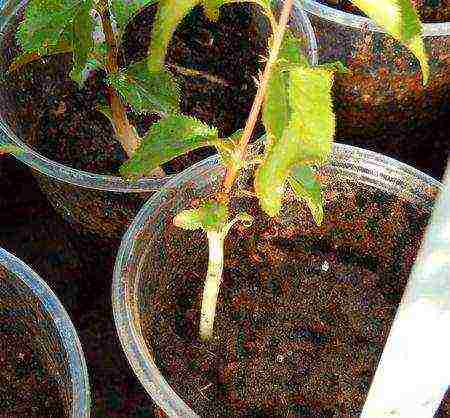
The emerging apricot sprout is immediately exposed on a light windowsill or under a phytolamp
The best temperature for the growth of apricot is + 24 ... + 26 ° С. Watering is carried out as the soil dries up.
Will an apricot grown from a stone bear fruit?
If you plant an apricot in open ground in the spring after return frosts, then there is a great chance that the seedling will take root and will bear fruit in a few years. But do not forget that apricot is a southern plant and in cold climatic conditions it often dies from frost.
When choosing a place for planting apricots in open ground, preference should be given to sunny places, without drafts and stagnant cold air. When groundwater is near, it is recommended to land on a hill. Apricot grows best on loamy soils.
Planting a seedling in the ground
It is worth planting an apricot seedling in the ground in the first spring, almost immediately after the emergence of shoots. Before the onset of autumn, the tree should get stronger, develop a good root system and prepare for winter. If this is not possible, then the apricot is first planted in a large container, and only then in the ground.
For such a compact plant, you do not need to make standard deep planting holes. Better to put a few buckets of compost in the soil and dig it up well. When transplanting a seedling into the ground, the plant should not be buried; the ground level should be the same as in the pot.
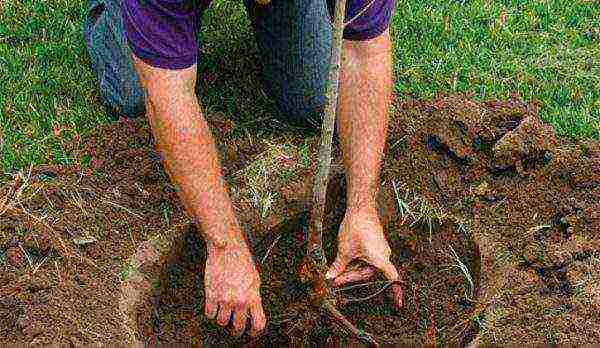
When transplanting an apricot into the ground, the plant must not be buried, the root collar must be open
The less you repot the plant from place to place and damage the root, the sooner you can see the fruit. The growth force of an apricot is enormous - in one summer, with proper care, it can grow by 1 meter.
Usually apricot from stone blooms in the 4th or 6th year.
Growing apricot in an apartment
If you wish, you can leave the apricot in the apartment and grow it as a houseplant. The place for the tree is chosen warm, with the morning rays of the sun, so the best option would be an east or south window.
You cannot feed the apricot with fresh organic matter in the first year, because it will constantly grow and will not be able to form good buds by winter.
Wintering should take place in a cool room, it is better if it is a winter garden or a cold cellar, where the temperature is kept within 0 ... + 2 ° С.It is necessary to place the apricot for the winter after the natural leaf fall has passed and the tree has dropped its leaves.
In winter, you also need to monitor the moisture content of the earthen coma in a pot or tub so that the roots do not dry out. In spring, apricot is brought into a warm place at the time of swelling of the buds or positive temperatures outside.

To grow apricots at home, you need to pick up a pots with a volume of 30 liters.
Since it is impossible to provide a bulky container to an apricot in room conditions, a large tree will not grow - a maximum of 1.5-2 meters. The pot is increased gradually, replanting the plant every year at a young age and every 3-5 years in an adult. For good growth and flowering, a tub of at least 30 liters in volume is recommended.
Do I need to graft apricot grown from a stone
Apricots grown from seeds are not always as tasty as those of the mother plant, so another variety can be grafted onto such a tree. In addition, if several varieties are inoculated into the crown, then the total yield of the plant will also increase due to cross-pollination.

If several varieties are inoculated into the crown of an apricot, then the total yield will increase.
It is possible to grow an apricot from a stone, but it will not begin to bear fruit very soon. For planting, choose local apricots that suit your taste and size - this will be more likely that trees grown from seedlings will take root well in your area.
Hello, my name is Irina, I am 33 years old. I love my collection of hippeastrum very much, but I do not offend other flowers either.
The fact that you can find different varieties of apricot seedlings on sale does not stop gardeners from wanting to grow them on their own. The idea of \ u200b \ u200bmaking a large tree out of a small bone, for some it occurs because of the high price of seedlings, for others - for the sake of experiment. Fearing that the apricot will not grow, gardeners are looking for a solution to this problem on the Internet. The following material will allow you to avoid mistakes in growing seedlings from seed at home.
Is it possible to grow an apricot from a stone at home
On this issue, the opinion of practitioners of growing seedlings of gardeners was divided. Some believe that a good apricot tree adapted to the climate can be obtained from the seed. Others argue that seedlings are best grown by grafting on stone fruit crops. The option with a bone will be successful if you know some of the subtleties of breeding them.... Otherwise, the apricot will turn out to be "wild".
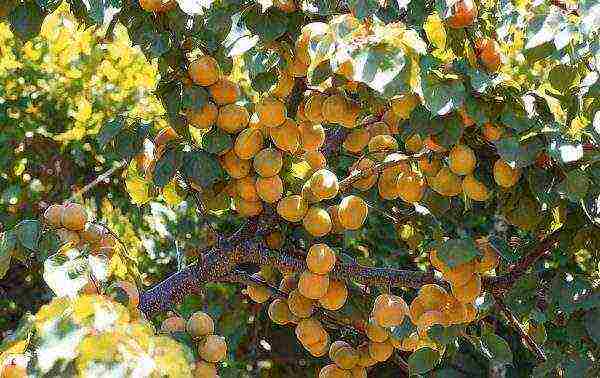 Wild apricot
Wild apricot
The stone method allows you to grow as many seedlings as you like. By subsequently selecting the strongest plants, you can get trees superior to their parents in taste and fruit size. It is best to take seeds from apricots that grow in your area as planting material.... If there is such an opportunity, you can order planting material from gardeners living in the Northern regions or Siberia.
Apricots growing in harsh climatic conditions will take root well in any region. When buying apricots for cultivation on the market, choose domestic fruits, they must be ripe and large. It is very difficult to grow imported varieties, but for the sake of experiment you can try... The resulting bones do not need to be split; it is enough to wash and dry them.
Where can you grow an apricot from a stone
In outskirts of Moscow
For growing seedlings, bones of hardy and self-fertile varieties should be taken. Heat-loving varieties will not work, they will not withstand the climate of this zone. It is better to give preference to frost-resistant trees. The most suitable varieties for the Moscow region:
- Red-cheeked
- Hardy
- Russian
- Honey
- Snegirek
- Northern triumph
In Central Russia
Apricots bred on the basis of the Botanical Garden of the Russian Academy of Sciences will feel good.Due to their biological characteristics, these varieties are distinguished by their hardiness and good adaptability. The varieties most adapted to the conditions of the given strip:
- Iceberg
- Alyosha
- Aquarius
- Countess
- Lel
- Monastyrsky
- Favorite
- Bai
In Siberia
Gardeners manage to grow seed apricots, even under the conditions of the harsh Siberian winter... The hardening of seeds and deep planting will help to achieve the survival rate of seedlings. It is very difficult to grow an apricot in Siberia, since in winter the ground freezes in places up to 2-2.5 meters. The most winter-hardy varieties for this region:
- Sayansky
- Mountain Abakan
- Kichiginsky
- Honey
- Chelyabinsk early
- Snezhinsky
- East Siberian
The conditions for growing apricots for these regions, in contrast to the South-East, require special conditions for planting, care and shelter for the winter.
It is preferable to plant frost-resistant varieties, otherwise the seedlings may die. Be sure to cover for the winter.
How to choose a seed for planting?
In the description above, it was already mentioned that it is better to take Far Eastern or Siberian apricot varieties as planting material. They are easier to germinate and take root better. If southern and Asian varieties are planted, they will freeze or grow very weak. For planting, take ripe, unspoiled fruits... The pulp should separate well from the stone. There should be no traces of mold, worms and chips inside the apricot. The removed bones must be washed with water. To prevent the bones from becoming moldy during storage, they need to be treated with hydrogen peroxide and dried.
Planting and growing conditions
Bones are planted in the soil in the fall, if this is done in the summer, they can be destroyed by rodents. Several seeds are sown at once, since not every one will grow. In order for the seedling to be hardened, it is necessary to produce artificial or natural stratification.... The procedure will allow you to grow strong and hardy seedlings for the northern regions from seeds without any problems.
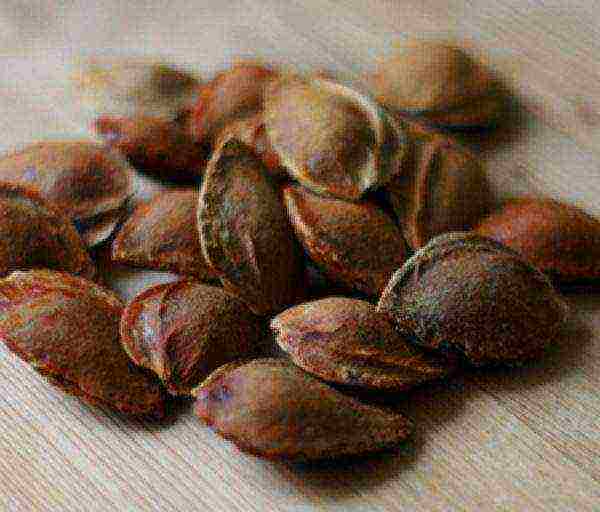 Before planting apricot pits, it is necessary to stratify
Before planting apricot pits, it is necessary to stratify
Natural stratification is carried out in the month of January-February. The bones must be placed inside the container with drainage holes. Cover them with damp sand, bury them in the ground, or just leave them outside... Artificially, the hardening procedure is carried out in the refrigerator. The container with sand and seeds is moistened, placed on the shelf of the refrigerator until spring.
Planting seeds:
- Bones matured under frosty conditions are transplanted into the ground with the onset of stable weather. In terms of timing, this period falls on March or April.
- The farther north the area, the deeper the seeds need to be planted. In Central Russia, the planting depth is 4-7 cm.
- So that the soil does not dry out, sowing needs to be watered regularly. Seedlings usually appear in May. Before the beginning of autumn, they need to be watered intensively.
- As soon as the seedlings grow up to a height of 5-7 cm, it is necessary to ensure loosening of the soil. This must be done carefully, otherwise the roots can be damaged.
- It is better to remove diseased and weak plants. at the initial stage of growing.
- The plant will root well if in the second half of summer apply nitrogen fertilizers.
- So that the seedlings do not freeze during wintering, they must be covered with cut plastic bottles.
For good pollination, it is better to plant several varieties at once. In dry weather, do not allow the soil to dry out. With an excess of moisture, you need to loosen the ground more often, this measure will save the roots from decay.
Transplanting a seedling into open ground
The first year the plant is not disturbed. When spring comes, pinch the top... Until autumn, the seedling is watered, fertilized and loosened. For the winter, they are covered with spruce branches. In the spring, the shelter is removed. The formed twigs are pinched again. If the growth of the seedling stretches in one direction, it can be tied up.
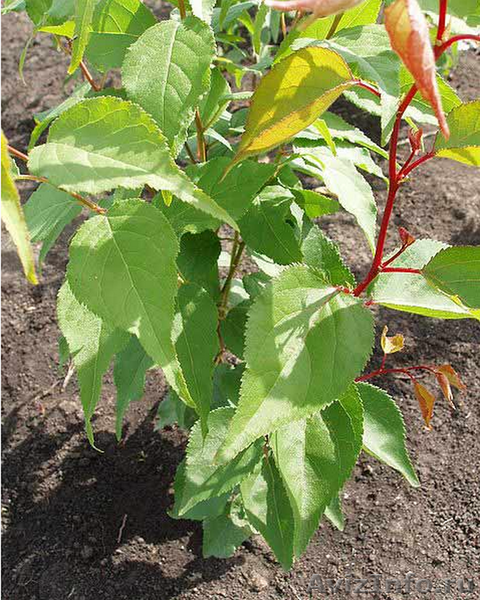 An apricot seedling is planted in the second year in spring or autumn
An apricot seedling is planted in the second year in spring or autumn
A biennial plant is transplanted into open ground to a new place in autumn or early spring.Planting sequence:
- Dig holes 50-60 cm deep... Place leaves, sawdust or branches at the bottom, they will act as drainage.
- Place a seedling on the bottom of the pit... Smooth out the root, it should not look out of the hole. Cover with earth, tamp and water abundantly.
- After planting, the seedlings are provided regular watering, at least 20 liters of water per hole.
The growth of the apricot must be constantly monitored. Patient and caring gardeners will surely grow a beautiful apricot seed garden. The fruits will look special, and their taste will be unique.... Thanks to the efforts, do-it-yourself apricots will become the pride of the gardener.
Care of a young seedling in spring and autumn
The growth of the tree depends on proper care. Therefore, it is so important to follow some rules. The entire growing period of a seedling requires more care than a perennial tree. The more effort will be spent on leaving, the more generous the harvest can be expected. General rules for caring for seedlings grown from seed:
- Fertilize apricots in autumn and spring... In order for the soil to breathe, it is loosened. Remove weeds.
- From the moment of transplanting the tree requires fungicide treatment from diseases and pests.
- For the seedling to be properly formed, trim... In summer, thin out the young shoots growing inward. Pruning will allow you to form a compact and easy-to-harvest tree.
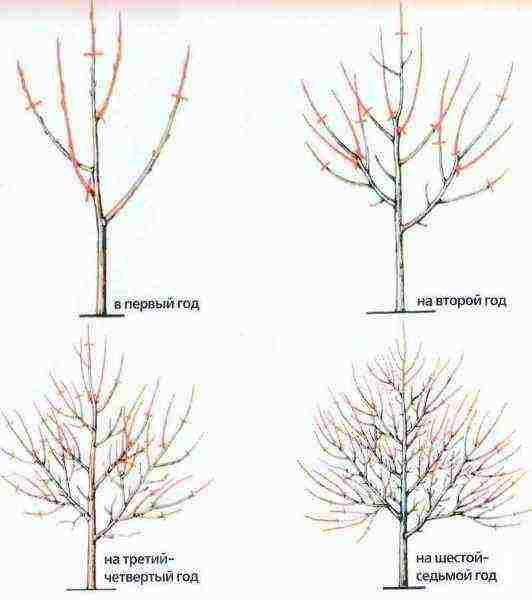 Scheme of pruning apricot by year
Scheme of pruning apricot by year
- For the winter, insulate the trunk with sacking... To prevent the wind from breaking a young tree, it should be tied to an even post.
- In the first year of flowering, it is better to remove the apricot inflorescences... This measure will allow for a rich harvest for the next season. The tree will give good crown growth.
Further care for a plant grown from a bone is the same as for a seedling purchased from a nursery. A tree grown in this way is more adapted to harsh climatic conditions. Such apricots are unpretentious, do not require special agrotechnical methods of care.
Gardeners, based on their observations, note: the fruits of such trees are less likely to get sick and are practically never wormy. Ripe apricots will taste different from their parent varieties. Thanks to such experiments, it is possible to obtain a variety that is unique in its characteristics.The tree will begin to bear fruit in 5-7 years.... If the seeds are planted after the first harvest, even more resistant seedlings of the second generation will grow. The presented material can be a great idea for a profitable business for growing apricot seedlings in your country house for sale.
 How to grow an apricot from a stone in the country - repeat the natural method of reproduction, accelerate it by stratification or grow seedlings in a pot - there are several options. But the gardener's ultimate goal is to get a weather-resistant fruit tree. We offer acquaintance with classical and alternative methods, from the unrecognized in the scientific world Zhelezov V.K., who works in Khakassia.
How to grow an apricot from a stone in the country - repeat the natural method of reproduction, accelerate it by stratification or grow seedlings in a pot - there are several options. But the gardener's ultimate goal is to get a weather-resistant fruit tree. We offer acquaintance with classical and alternative methods, from the unrecognized in the scientific world Zhelezov V.K., who works in Khakassia.
Growing an apricot from a stone
 Before us is a ripe apricot bone. It separates easily from the pulp. If you free the nucleolus, it is sweet. Only such seeds are suitable for sowing.
Before us is a ripe apricot bone. It separates easily from the pulp. If you free the nucleolus, it is sweet. Only such seeds are suitable for sowing.
The apricot kernel retains in memory not only maternal properties. In it, as in a human baby, the generic characteristics of previous generations are collected. The new tree will be special. It can give rise to a new strain, or it can turn out to be a dummy. But we will find out about this only after 6-7 years, when the apricot from the stone will bear fruit.
An apricot orchard can be planted in not only warm latitudes. The tree has adapted to the climate of the Moscow region, Orenburg, Khakassia, Eastern Siberia. It is noteworthy that only trees grown from seeds endure weather disasters and survive. They endure frost - 40 and +40 heat. It is important to use seeds from the first harvest of the zoned variety. The adaptation of such a plant to the local climate is high. Consider ways how to grow apricot seeds.
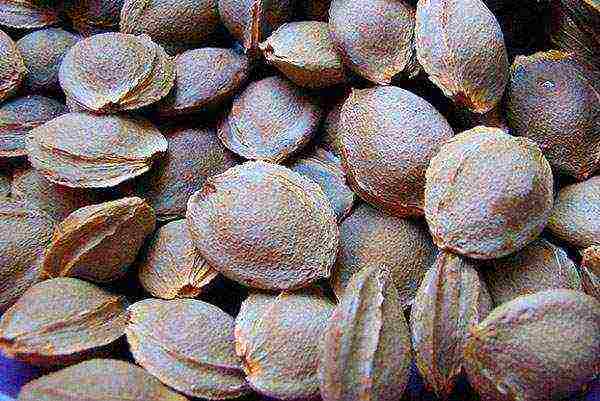 You can dip a fresh seed into the hole for natural germination. But there are many hunters for the sweet nucleolus, it will be eaten by insects or carried away by rodents. Of course, you can plant it in a pot and get a houseplant. A pampered sapling planted in open ground will be weakened. Therefore, the development of apricot must take place in natural or approximate conditions. So how do you germinate an apricot pit?
You can dip a fresh seed into the hole for natural germination. But there are many hunters for the sweet nucleolus, it will be eaten by insects or carried away by rodents. Of course, you can plant it in a pot and get a houseplant. A pampered sapling planted in open ground will be weakened. Therefore, the development of apricot must take place in natural or approximate conditions. So how do you germinate an apricot pit?
When choosing apricots, in order to take seeds from them for propagation, you need to buy fruits of local varieties. There is no guarantee that a young plant will survive until the first harvest if seeds of Asian, imported or southern varieties are planted in the Moscow region.
Preparation of planting material
 Getting apricots and their pits goes in several stages:
Getting apricots and their pits goes in several stages:
- The preparation of the seed begins with the choice of planting material - ripe apricot kernels. The washed bones dry well and clean the dry ventilated room. It is supposed to sow them in the ground with the onset of frost. During the winter, the bones in the ground will undergo natural stratification - hardening.
- How to plant an apricot from a stone if winter has already come, and the seeds are not yet in the ground? It is necessary to carry out stratification. At the end of January, the seeds are placed in wet sand in a box with drainage holes. Place the box in a trench in the garden and cover with snow. As a last resort, lower the box into a cellar with a temperature of +2 degrees and store until April. The sand should always be moist.
- Is it possible to grow an apricot from a stone in the country, if the material is dry, and it's already March outside? Put the bones in melt water for three days. Those that come up are thrown away. Change the water, avoiding acidification. Mix sawdust with river sand, periodically freeze in the freezer and keep on the fruit shelf of the refrigerator until the time of sowing in the ground.
When sowing in the ground, you need to remember that not all seeds will sprout, much less grow. It is necessary to do thickened crops.
Planting apricot seeds
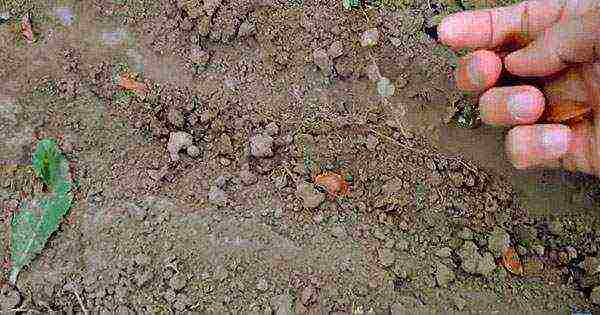 Autumn planting of drupes is carried out when the first frost falls on the ground. A fertile air-permeable layer consisting of humus, straw, black soil, sand is stuffed into a trench dug on a shovel bayonet. The trench is filled, the drupes are laid to a depth of 5 cm and sprinkled on top with the same mixture. Not all seeds will sprout, only the strongest.
Autumn planting of drupes is carried out when the first frost falls on the ground. A fertile air-permeable layer consisting of humus, straw, black soil, sand is stuffed into a trench dug on a shovel bayonet. The trench is filled, the drupes are laid to a depth of 5 cm and sprinkled on top with the same mixture. Not all seeds will sprout, only the strongest.
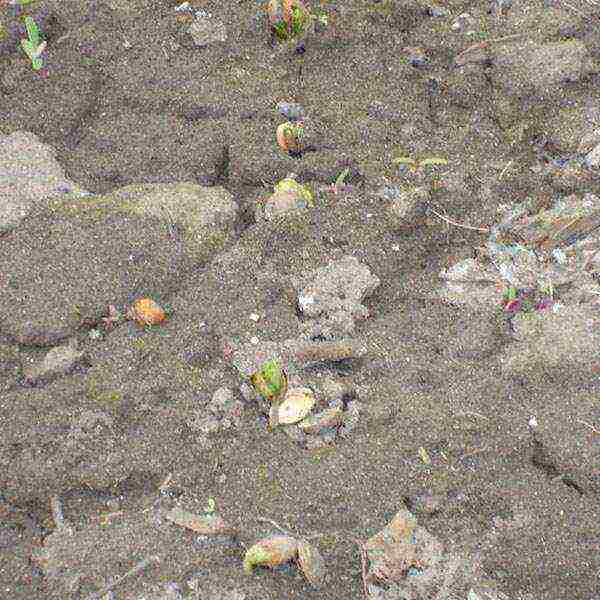 The Siberian gardener Zhelezov claims that the depth chosen for planting the seeds is wrong. Planting should be shallow, only then the root collar will be in a comfortable environment. But it is impossible to plant it completely on the surface - birds and rodents will take it apart. He proposes to sprinkle the sowing 1 cm with earth.Such seeds will go through 7 circles of hell:
The Siberian gardener Zhelezov claims that the depth chosen for planting the seeds is wrong. Planting should be shallow, only then the root collar will be in a comfortable environment. But it is impossible to plant it completely on the surface - birds and rodents will take it apart. He proposes to sprinkle the sowing 1 cm with earth.Such seeds will go through 7 circles of hell:
- temperature drops;
- some will die during provocative thaws;
- will be eaten by mice and birds.
The emerging seedlings are no longer afraid. They endure frosts of forty degrees, provocative thaws do not affect them. I spied on this method of planting practices from nature, from a local wild variety - Manchurian apricot. Part of the mass of seeds lying on the surface gives strong shoots.
Zhelezov's experience in planting from a stone and caring for an apricot shows that out of 1500 seeds, only 170 will sprout. With forced stratification, 900 seeds will sprout out of 1000. But there is no price for seedlings that survived despite all the troubles.
Growing seedlings
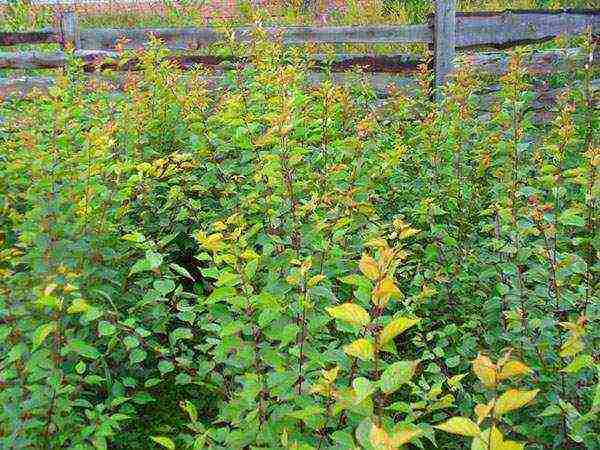 Growing an apricot from a stone after germination is not difficult. The tree can be grown as self-root, without grafting. If initially the drupe ascended in the designated place, it is ideal. There should be at least 2-3 trees in the garden for better pollination.
Growing an apricot from a stone after germination is not difficult. The tree can be grown as self-root, without grafting. If initially the drupe ascended in the designated place, it is ideal. There should be at least 2-3 trees in the garden for better pollination.
If the seedlings need to be transferred to a permanent place, a pit is prepared, into which organic matter is added, in the form of plant residues, ash, humus. A seedling is rooted in a soft litter. Water the plants infrequently, with cold water. Pitted trees rarely have a central trunk, so shaping is required.A feature of own-rooted apricots is their resistance to diseases and pests.
How to grow an apricot from a stone, plant a seedling, or grow wild, each gardener decides for himself.
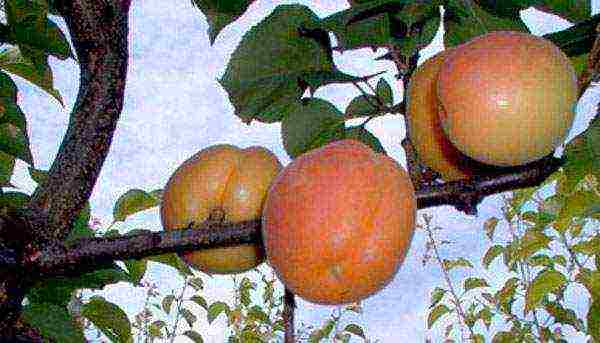 For those who do not have a summer cottage, but want to have their own apricot, you can start a house tree in a pot, it will grow up to 1.5 m. It is not difficult to take care of a home apricot - watering, transplanting and pruning. The tree leaves in winter to rest, and in summer it can perfectly live in a room or on an open loggia. At the same time, the apricot, with proper care, will delight you with spring flowering and sunny fruits.
For those who do not have a summer cottage, but want to have their own apricot, you can start a house tree in a pot, it will grow up to 1.5 m. It is not difficult to take care of a home apricot - watering, transplanting and pruning. The tree leaves in winter to rest, and in summer it can perfectly live in a room or on an open loggia. At the same time, the apricot, with proper care, will delight you with spring flowering and sunny fruits.
Recommendations for growing apricot from stone - video
We sow bones in the fall - video


